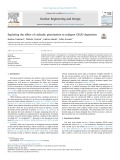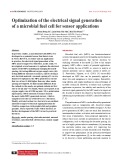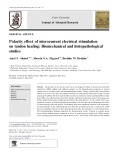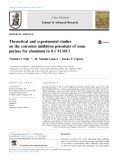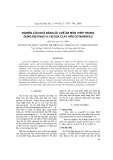
Cathodic polarization
-
Cathodic polarization is investigated as a technique for CRUD build-up mitigation in simulated primary pressurized water reactor conditions and accelerated flow. This investigation showed that the application of 3 V could induce a 67% reduction in surface deposition whilst 30 V cell voltage completely prevented the formation of surface deposits.
 6p
6p  vironald
vironald
 15-12-2022
15-12-2022
 8
8
 3
3
 Download
Download
-
The process resulted into a removal efficiency of 91.8 % of COD, 94.3 % in the case of BOD and 96.5 % in the case of turbidity after treatment of 30 minutes with the combination of Al (at cathode) and Fe (at anode) with mono-polar electrode connection in parallel.
 8p
8p  thebadguys
thebadguys
 15-01-2022
15-01-2022
 16
16
 0
0
 Download
Download
-
In the past years there has been a great interest in self-doped TiO2 nanotubes (blue TiO2 nanotubes) compared to undoped ones owing to their high carrier density and conductivity. In this study, blue TiO2 nanotubes are investigated as photoanode materials for photoelectrochemical water splitting. Blue TiO2 nanotubes were fabricated with enhanced photoresponse behavior through electrochemical cathodic polarization on undoped and annealed TiO2 nanotubes.
 13p
13p  tudichquannguyet
tudichquannguyet
 29-11-2021
29-11-2021
 10
10
 0
0
 Download
Download
-
The presence of boric acids, saccharin or 1,4-butynediol have increased cathode polarization, inhibited precipitation alloy and shifted discharge potential of Ni2+ about 100 to 150 mV towards more negative. The solution temperature strongly affected on the polarization curve over the full range of investigated electrode potential, the cathode current increased about 1.5 times when the temperature increases from 30 to 50 oC.
 5p
5p  nguaconbaynhay11
nguaconbaynhay11
 16-04-2021
16-04-2021
 8
8
 1
1
 Download
Download
-
This study we attempt to (i) discover a better performing electrode material to minimize the internal resistance of the MFC, (ii) modify the anodic electrode spacing to determine a design that better supports the electrochemical activity of acting bacteria, and (iii) reduce losses during the electron transfer process (from the electron donor at the anode to the electron acceptor at the cathode) via optimization of the cathode oxygen supply rate and the external resistance using polarization analysis.
 7p
7p  chauchaungayxua8
chauchaungayxua8
 02-10-2020
02-10-2020
 17
17
 1
1
 Download
Download
-
The purpose of the current study was to investigate the effect of microcurrent electrical stimulation (MES) applied with different polarity on the biomechanical properties of injured tendons and to correlate results with histopathological studies. Ninety six male white New Zealand rabbits were used in the study. Six rabbits were kept as normal group with intact tendons and the remaining 90 rabbits with their right Achilles tendons tenotomized, sutured and immobilized. After that rabbits were allocated into equal three groups; cathodal, anodal and control.
 9p
9p  kethamoi1
kethamoi1
 17-11-2019
17-11-2019
 16
16
 1
1
 Download
Download
-
Experimental aspect of the corrosion inhibition potential of adenine (AD), guanine (GU) and, hypoxanthine (HYP) was carried out using weight loss, potentiodynamic polarization and electrochemical impedance spectroscopy (EIS) methods while the theoretical aspect of the work was carried out by calculations of semi-empirical parameters (for AM1, MNDO, CNDO, PM3 and RM1 Hamiltonians), Fukui functions and inhibitor–metal interaction energies.
 15p
15p  trinhthamhodang1
trinhthamhodang1
 16-11-2019
16-11-2019
 19
19
 1
1
 Download
Download
-
Corrosion inhibition of organic clay nanofil5 in NaCl 0.1 M solution was studied by polarization curves and electrochemical impedance spectroscopy. The clay concentrations studied were between 1 g/l and 5 g/l. The clay nanofil5 plays both anodic and cathodic corrosion inhibition. The corrosion inhibition of clay nanofil5 depends on the concentration. The results obtained by two methods were in good agreement and showed that the highest inhibition efficiency was obtained with the nanofil5 concentration of 3 g/l.
 6p
6p  uocvong01
uocvong01
 24-09-2015
24-09-2015
 49
49
 2
2
 Download
Download
-
Introduction In 1791, the first combination of metals in Volta’s battery involved zinc as the negative electrode. A zinc electrode was also used in subsequent Daniell, Grove, and Bunsen cells developed in the early nineteenth century. Those cells were strictly powered by zinc dissolution and cathodic hydrogen evolution.
 10p
10p  congdat261
congdat261
 02-12-2010
02-12-2010
 98
98
 11
11
 Download
Download
CHỦ ĐỀ BẠN MUỐN TÌM








